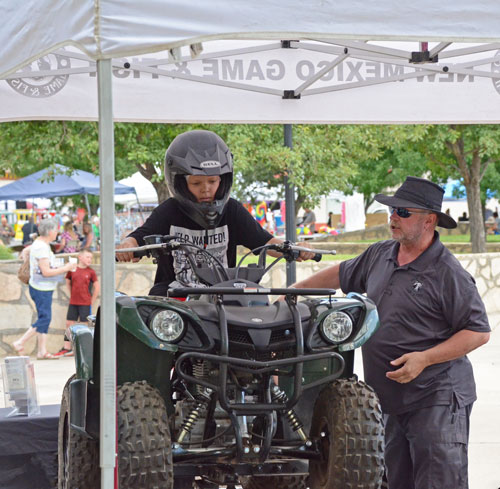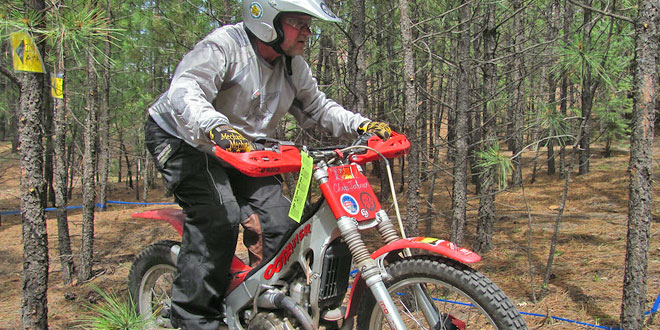As I write this today, my family and I are all at home. My wife and I are telecommuting, our oldest is home from Arizona State University and our twins are still officially on Spring Break. We are keeping up on the latest news about the COVID-19 coronavirus outbreak, and trying to make sure we are well-prepared for the changes our society has been experiencing.
One of the ways I have coped with stress throughout my life is by going riding. Time spent on a motorcycle is therapeutic – I call it ‘cycle-therapy’.
Getting out on the trails and back roads of our beautiful state helps me leave my worries behind for a while. Just the act of riding focuses my attention: rolling on the throttle, changing gears, shifting my weight and looking through the turns. The physical and mental demands of riding clear my mind and reinvigorate my spirit. But is this really a good time to go riding?
I’m reminded of a time when my family faced a more local crisis, back in May of 2000 during the evacuation of Los Alamos because of the Cerro Grande fire. We ended up on the in-laws’ farm for nearly two weeks; the only thing we knew of our home was the nightly news showing helicopter video of the same houses burning over and over again.
For reasons too complicated to relate here, I happened to evacuate with my dirt bike in my van. After several days of worrying whether we still had a home, I decided to go riding to clear my mind. The farm is very close to a Bureau of Land Management Off-Highway Vehicle Area commonly known as Alcalde, with a wonderful trail system and amazing views of the northern mountains and Rio Grande valley. After several hours of riding the arroyos and ridgeback trails I felt so much better. I rode back to the farm better able to deal with the uncertainty of the times. After a few days, the evacuation was lifted, and we returned to find our home undamaged, though other Los Alamos residents weren’t nearly as fortunate.
Now I feel the same need – to go riding to reset myself, gain respite from the stressors, and return a stronger person able to lead my family. But the health care professionals and politicians who are working to keep us safe are urging us to ‘hunker down’ in our homes to minimize our potential exposure to infection.
But safe riding recommendations include not going out alone, so having a riding buddy along means compromising the idea of ‘social distancing’ at least a little bit. Riding with someone you can count on in an emergency also means, in this case, someone who has not been exposed to the virus.

So, maybe it’s not the right time to go riding, but you can still spend some social isolation down-time with your Off-Highway Vehicle (OHV), and be assured that when the time is right, you and the machine will be ready to go.
A common resource for OHV maintenance is the T-CLOCK pre-ride checklist, which is also handy for periodic maintenance. It works for motorcycles, ATVs, side-by-sides, OHVs or even street-legal machines.
T: Tires and Wheels – check tire pressures and airtight integrity. Look for tread wear, foreign objects and signs of damage to rims or spokes. Make sure axle nuts or lug nuts are tightened to recommended torque values.
C: Controls – make sure all the controls work as intended, smoothly and reliably. Adjust control positions for the intended operator. Lubricate control cables, but avoid lubricants that attract dirt. This is a good time to inspect the safety features in a side-by-side cabin: seat belts, handholds, doors or safety nets and the hardware securing the rollover protection structure (ROPS).
L: Lights and Electrics – make sure all the lights and electrical switches work. OHVs may have headlights and taillights, even brake lights. Check accessories such as winches or other electrical equipment. Batteries may need a fresh charge, electrolyte top-off (except for sealed/maintenance-free batteries) or even replacement.
O: Oil and Fluids – check the levels and quality of various fluids the machine needs for good operation. Change the engine and transmission oils and filters, top off or replace the coolant in liquid-cooled machines and check the level and condition of hydraulic fluid in brake and clutch systems — fresh fuel with stabilizer added is a good idea. Don’t forget to clean or replace air filters.
C: Chain/Chassis – this is drivetrain maintenance according to the type of machine. Most off-highway motorcycles and some ATVs use a chain and sprockets that will require occasional inspection, adjustment and lubrication. Other ATVs and motorcycles use a shaft drivetrain, which doesn’t usually require adjustment but operates in a gear oil bath that requires infrequent replacement. Some ATVs and side-by-sides have a drive belt that should be inspected for wear and may require adjustment.
The “chassis” refers to all the other parts of the machine not covered above: things like looking for loose hardware or bodywork; lubricating suspension pivot points and checking for smooth, quiet operation; inspecting the frame and mounted accessories. The more closely you look at a machine, the more likely you’ll catch little problems before they become big problems.
K: Kickstand – applies to motorcycles only. Look at the condition of the pivot point and the springs that keep the stand retracted.
Each machine is unique. For the best information on your ride, look to the owner’s guide, maintenance manual and internet resources, and don’t forget to check with your local dealer for recommendations. Just make sure to have complete vehicle information (year/make/model) handy when you call the parts department.
OHVs are not the only pieces of outdoor equipment to prepare for your next hunt. Visit the Department of Game and Fish webpage to learn how to clean your firearm. Click here for the tutorial: http://www.wildlife.state.nm.us/download/education/conservation/non-correlated-curriculum/activities-and-how-to/How-to-clean-your-firearm.pdf
 New Mexico Wildlife magazine Conserving New Mexico's Wildlife for Future Generations
New Mexico Wildlife magazine Conserving New Mexico's Wildlife for Future Generations
